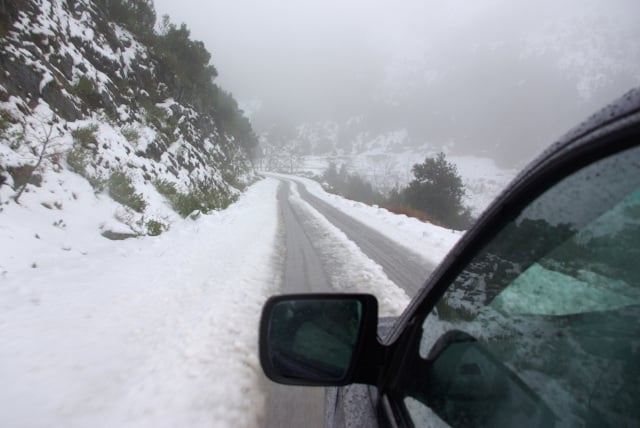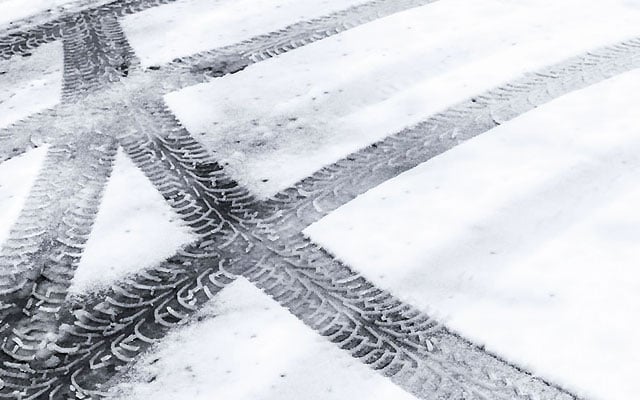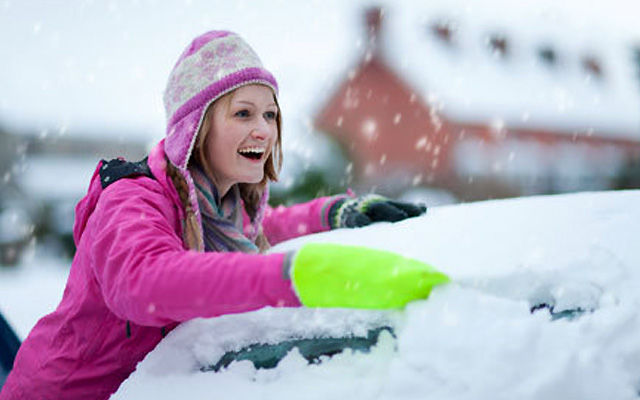
Driving in snow and icy conditions can present motorists with several challenges. Freezing temperatures can mean that you might struggle to get your car started in the first place, while low visibility and slippery road surfaces can make driving a struggle.
That’s why it’s key to take good care of your vehicle and adjust your driving style to the conditions. We’ve put together an expert guide (written by AA patrols) to help you – read on for our top tips.
We provide 24/7 roadside assistance.
How to drive in snow
In short, our key tips for driving in snow are:
- Accelerate gently when moving off in snow, avoiding harsh speeds that could cause wheelspin
- Start off in second gear using low revs, and ease your foot off the clutch gently
- Instead of using the brake pedal, cycle down the gears to use engine braking (you can tap the brake pedal lightly to make drivers behind aware that you’re slowing down)
- Leave plenty of room between your vehicle and the one in front
- Stay in a higher gear and avoid braking as much as you can
- Use your headlights in heavy snow
- If you do start skidding, stay calm, steer into the skid and avoid sudden movements like hitting the brakes
- If your driving an electric or hybrid car, adjust the regenerative braking to a lower setting
Deciding whether to drive in snow
Driving during bad weather should start with the basic question: do I need to leave the house? If you can avoid driving when conditions outside are unpredictable and potentially dangerous, you should. And if you can plan around forecast weather warnings, you might be able to avoid the worst of it.
But if you have to be on the roads when the snow’s falling and the temperature’s dropping, here are some things you can do to stay as safe as possible.
Before you start driving in the snow
Plan your journey – by preparing your route beforehand, using our AA route planner, sticking to main roads (which are more likely to be gritted and cleared) and keeping an eye on any traffic updates, you stand a better chance of avoiding an incident or serious delay.
Get your car in shape for the snow – much like we bundle ourselves up and make sure we’re physically ready for the weather, your car needs some hands-on preparation too.
De-ice and de-mist your windscreen
It’s illegal to drive without full vision, so you’ll want to make sure to properly defrost your car windscreen before setting off. In short, you’ll need to:
- Make sure your wipers are switched off and aren’t frozen to the glass before you start your car
- Start your engine and turn on your windscreen and rear window heaters, if you have them, along with the air-con, and stay with your car while it clears up
- Clean off any excess snow from your car and front grille with a soft brush
- Wait for all of the glass to completely clear before driving
- If you own an electric or plug-in hybrid, pre-heating may be available while on charge
Make sure your lights are working
Ensure all your lights are working and visible. Clean off any snow and dirt before any journey. This will allow you to see clearly but also to be seen by other road users.
Read our advice on keeping your car clean.
Check your fuel or EV charge
This one might seem simple, but if you run out of fuel or EV charge in the winter, then you won’t be able to keep warm in your car in the event that you get stuck or have a breakdown. Believe it or not, a large number of breakdowns attended by AA patrols are for empty fuel tanks.
Expert tips for driving in snow
- Make sure to wear warm clothing, with appropriate footwear (make sure your footwear is dry so that you don’t slip off any of the pedals – you can keep a small towel in your car for this)
- Bring a pair of sunglasses (heavy snow can cause glare from the sun, reducing your visibility)
- Set off earlier than you would if you’re making the journey to work or travelling a route you always travel. This will allow you to have the extra time to drive calmly and sensibly
- Be gentle on the throttle, avoiding any harsh acceleration which is likely to cause wheel spin
- In manual-geared cars, pull away in second gear, easing your foot off the clutch gently to avoid wheel spin
- To slow down, use engine braking through the gears – just touch the brake pedal lightly to show brake lights to others behind
- If you're driving an electric or hybrid car, adjust the regenerative braking to a lower setting
- Leave as much room as you can between your vehicle and the one in front of you
- If you're approaching a hill, drop well back or wait until it’s clear of traffic so you won’t have to stop part-way up. Keep a constant speed and try to avoid changing gear on the hill
- Take bends in the road slowly, making sure to brake before you start turning the steering wheel
- If you do start to lose control or skid, it’s important to remain calm. Make sure to steer gently into any skid and don’t make any sudden movements like braking harshly
- Use a higher gear and try to avoid braking throughout your journey. Shift down through the gears to slow down
- If you drive an automatic car, check your manual to see if your car has a setting for icy conditions
- Use your headlights in heavy snow. Daytime running lights won't be enough, and there’ll be no lighting at the back of your car. You’ll need to make sure you can see ahead and cars behind you know you’re there
- If you’re driving in heavy snow, be aware that the parts of the road with tyre tracks from other drivers are likely to be more icy than anywhere else
- Think about your current driving environment. Just because the conditions might have improved on main roads, country roads or bridges might still be hazardous due to less traffic or because they've not been gritted
- When you're driving in icy conditions or snow, you should always be more cautious for at least a few days after
What’s the stopping distance in snow?

In bad weather conditions, remember that a car’s stopping distance will be considerably longer. Also, if snow is falling heavily it will reduce how far ahead you can see, so you should drive much more slowly and give yourself longer to react. Secondly, braking distances can be doubled in wet conditions – and increased by at least 10 times on snow or ice.
The stopping distance at 30mph in normal conditions is 23 metres, which equates to 75 feet. In snowy conditions, your stopping distance at 30mph could be as high as 230 metres or 750 feet.
How to drive on ice
The advice for driving on ice doesn’t differ too much from driving in snowy conditions. If possible, avoid driving, but if you must drive, make sure to prepare well before you set off – check your fuel and make sure your mobile phone is fully charged (in case you get stuck).
When driving, accelerate gently, get into a higher gear as soon as possible, and reduce your speed in general. Keep an eye on the vehicle in front of you as this can give a clue to where patches of black ice are (you may see the vehicle in front skidding slightly).
Driving on black ice
Black ice is a thin layer of ice on the road surface that’s usually transparent. Because it's very difficult for drivers to see, it can be one of the biggest dangers of winter driving. It’s important you know how to react if you hit a patch of black ice on the road. Black ice is caused by rain falling on frozen surfaces. It tends to form on parts of the road that don’t get much sun – tree-lined routes and tunnels – as well as on bridges, overpasses and the road beneath overpasses.
When it's cold and there's a risk of ice:
- If it's slippery, do everything slowly as things can go wrong very quickly.
- Avoid harsh braking and acceleration or aggressive steering; reduce your speed smoothly and use brakes gently.
- If you do hit black ice, keep calm and avoid sudden or aggressive manoeuvres – don’t hit the brakes but lift of the accelerator fully and try to keep the steering straight, allowing the car to pass over the ice.
Do you need winter tyres?
Check our full guide about winter tyres.
Most drivers will get some safety benefit from fitting winter tyres because of the improved grip they provide in cold and wet conditions – they're not just for snow and ice. But they're an expensive option and not without hassle as you'll have to store a set of tyres and swap them over twice a year.
As an alternative to winter tyres, consider 'all-season tyres' which can be left on all year round.
Or if you live in a rural area where snow's common but roads rarely gritted, then a set of snow chains to get you to the nearest main road might be the answer.
Do you need snow socks or snow chains?
Snow socks (tyre socks) and snow chains are generally used less in the UK compared to other countries in Europe. If you live in a somewhat busy area, the likelihood is that you won’t need snow socks or snow chains because our roads are often gritted in the winter. However, if you live in a more rural area where there’s less chance of gritting, then you might want to consider purchasing some to keep in your car, just in case.
If you’re planning to travel to countries like Austria, Germany, France and Switzerland, it’s actually mandatory to have snow chains or snow socks in certain areas, so make sure to do your research before setting off.
Is it illegal to drive with snow on your car?

It’s not illegal to drive with snow on your car, but the law does stipulate that all the windows on your car need to be clear so that you can see through all of them. It would make sense to always clear your roof and windows of snow at the very least. Snow on the top of your car could slide and shift when you brake and accelerate, for example, and fall onto your windscreen, obstructing your view of the road.
If you get into an accident with snow on your windows, this could be viewed as dangerous driving.
How to drive uphill in snow
If you're approaching a hill, make sure to drop well back or wait until it’s clear of traffic so you won’t have to slow down or stop while at an incline. Keep a constant speed and try to avoid changing gear on the hill. If you can get to the top of the hill smoothly then you’ll reduce your chances of stalling or getting into trouble half way up.
How to drive downhill in snow
When driving downhill in snow, don’t use the neutral gear if you’re in a manual car. Instead, use a low gear and only use the brakes gently if you need to. Ideally, use engine braking by going down through the gears with very light taps of the brake to show any road users behind you that you’re slowing down.
As with driving uphill in snow, try to hang back and let traffic clear (if there’s nobody behind you) so that you can traverse the hill without stopping and starting in traffic.
How to drive rear-wheel drive in snow
Again, our advice would for driving a rear-wheel vehicle in the snow would be to leave plenty of time for your journey, so that you can drive a bit slower. If you find that your rear wheels aren’t getting much traction, you can also try weighting down the rear of your vehicle with sandbags or bags of dirt. Place these in the boot for the best effect.
Alternatively, you can also invest in snow chains or snow socks for your tyres, if the rear-wheel drive is making things particularly challenging.
How to drive front-wheel drive in snow
For front-wheel drive cars, you should avoid accelerating into turns, as this will cause under steer and a loss of control. Instead, ease off the acceleration and approach turns at a lower speed than usual. Snow tyres and snow socks can help if you’re losing control often in a front-wheel drive car.
Generally, you should anticipate any movements you’ll need to make ahead of time so that you can be fluid and smooth, rather than hurried. Jerky movements are your enemy when driving a front-wheel-drive car in the snow.
How many inches of snow is unsafe to drive in?
Driving in light snow is significantly more dangerous than driving in clear conditions. So, if you have a large amount of snow and your journey isn’t essential, it’s best to avoid driving if possible. Generally, a car with large snow tyres (with either snow chains or snow socks equipped) would be able to handle 4-6 inches of snow relatively well. More than this, and you’ll be taking a significant risk.
How to drive an automatic car in snow
Our advice for driving an automatic car in the snow is the same as for a manual vehicle. Plan ahead, drive slowly, and anticipate your moves so that you won’t have to make any sudden decisions while driving.
If you have a newer model of automatic car, do check if you have a ‘snow mode’ or ‘winter driving mode’ – these will ensure that your car sets off in second gear, avoiding wheel spin. Power delivery to the wheels will also be reduced, giving you more control. You won’t be able to use engine braking in an automatic car, so it’s vital to reduce speed and only brake gently.
